Is your current tech holding you back?
Relying on outdated computer vision tools often leads to errors and slows down your critical workflows, from inventory tracking to customer analytics.
The pressure is on. Choosing the wrong tool disrupts projects and wastes budget, a major risk you simply cannot afford to take.
Many vendors make conflicting claims about their accuracy and API efficiency. This information overload makes finding a solution that truly fits incredibly difficult.
The right software cuts through all that noise. It ensures you can power your projects with accuracy and integrate with your existing workflows.
Speaking of efficient workflows, addressing your data integration challenges is crucial for any project.
In this article, I’m going to guide you through the best image recognition software, focusing on implementation success factors, not just technical specifications.
You’ll discover scalable solutions with transparent pricing and the robust developer documentation needed to accelerate your deployment and prove ROI.
Let’s dive in.
Quick Summary:
| # | Software | Rating | Best For |
|---|---|---|---|
| 1 | Google Cloud → | Technical product managers | |
| 2 | Amazon Web Services (AWS) → | Enterprise-scale businesses | |
| 3 | Microsoft Azure → | Technical product managers | |
| 4 | Clarifai → | Solutions architects | |
| 5 | Imagga → | Developers and businesses |
1. Google Cloud
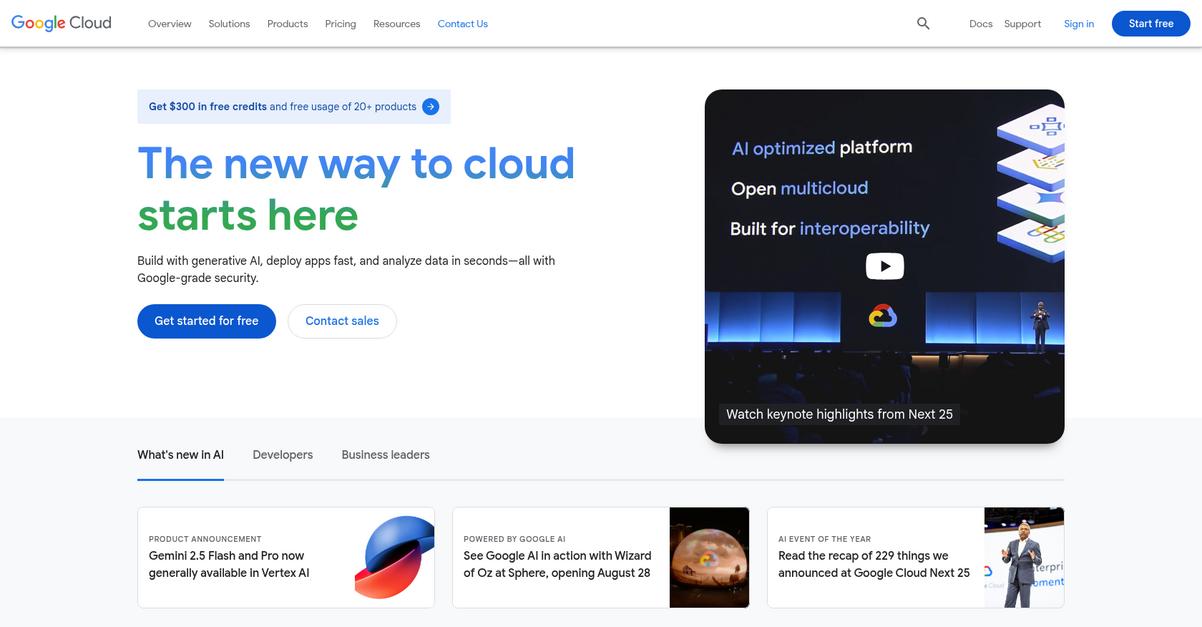
Struggling to scale your image recognition capabilities?
Google Cloud’s Vertex AI offers a unified AI platform, letting you build and deploy AI applications, including those powered by multimodal Gemini. This means you can handle various image recognition tasks efficiently.
This addresses the pain point of outdated computer vision tools failing to scale or manage edge use cases, giving you the power to build and train advanced AI models.
Here’s how to elevate your projects.
Google Cloud empowers you to build with generative AI, deploy apps fast, and analyze data in seconds, all backed by Google-grade security. This offers scalable solutions that integrate seamlessly with custom workflows.
You can leverage Vision AI, providing custom and pre-trained models to detect emotion, text, and more, which is crucial for handling diverse image analysis needs. This flexibility ensures reliable performance even in uncontrolled environments. Additionally, Google Cloud’s AI and machine learning products allow you to build fully managed AI agents and generative AI applications, enhanced by over 200 foundation models. This makes complex tasks like defect detection and personalized ad targeting more accessible.
The result is measurable improvements in operational efficiency and customer engagement.
Key features:
- Vertex AI Platform: A unified platform that enables you to build, tune, and deploy both ML models and generative AI applications, including those powered by Gemini.
- Vision AI Capabilities: Provides access to custom and pre-trained models for detecting emotions, text, and more in images, addressing diverse recognition needs.
- Google-grade Security: Ensures your data and applications are protected against threats and fraudulent activity with the same security technology Google uses.
Google Cloud features, pricing, & alternatives →
Verdict: Google Cloud offers a powerful suite of AI and machine learning tools, making it one of the best image recognition software choices for technical product managers and solutions architects. Its Vertex AI and Vision AI capabilities, coupled with Google-grade security, allow for scalable, real-time image processing. The Home Depot, for example, uses Google Cloud’s computer vision to manage inventory, showcasing its real-world effectiveness.
2. Amazon Web Services (AWS)

Struggling with complex image recognition software choices?
AWS offers flexible, scalable, enterprise-ready Artificial Intelligence (AI) solutions, including those for language understanding and MLOps. This means you can confidently develop cloud-centered applications and manage high-performance computing (HPC) workloads.
You can address advanced feature requirements and scale with expanding data volumes, overcoming evaluation paralysis.
Find solutions built for the future.
AWS provides the broadest and deepest set of cloud capabilities, offering you the greatest choice and flexibility to meet your specific needs. You get purpose-built tools for the best cost and performance, including a comprehensive set of AI and data services. This allows you to build, train, and deploy machine learning models at scale. Additionally, Amazon Web Services (AWS) ensures security and compliance at scale, crucial for sensitive industries like healthcare and financial services, and provides unmatched reliability for your most demanding workloads.
The result is measurable improvements in operational efficiency and customer engagement, whether for personalized ad targeting or defect detection.
Key features:
- Flexible AI Solutions: Access enterprise-ready Artificial Intelligence (AI) services for use cases like language understanding and MLOps, ensuring tailored solutions for your unique projects.
- Scalable Machine Learning: Utilize Amazon SageMaker to build, train, and deploy machine learning models at scale, handling expanding data volumes and complex real-time processing demands.
- Secure & Reliable Infrastructure: Benefit from a cloud environment designed with over 300 security, compliance, and governance services, ensuring data privacy and trusted performance for critical workflows.
Amazon Web Services (AWS) features, pricing, & alternatives →
Verdict: If you’re seeking the best image recognition software that combines unparalleled flexibility, scalable AI capabilities, and robust security, Amazon Web Services (AWS) is an ideal choice. Its purpose-built tools and extensive operational experience empower you to innovate faster, lower costs, and confidently deploy critical workflows, transforming your operational efficiency.
3. Microsoft Azure
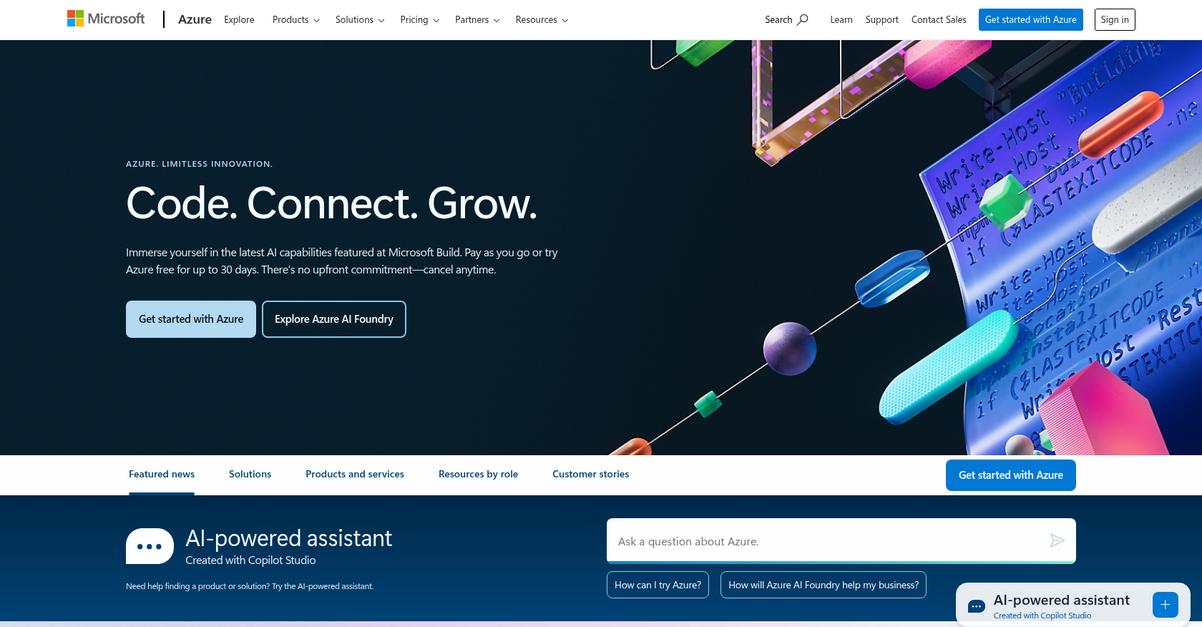
Struggling with complex image recognition challenges?
Microsoft Azure offers specialized AI services, including Azure AI Vision and Azure AI Content Safety, built to handle advanced vision tasks. This means you can confidently tackle issues like real-time processing and compliance.
Azure AI Vision provides capabilities for deep insights from image and video analysis, including OCR and AI, making it ideal for scaling data volumes and handling edge cases. This helps avoid evaluation paralysis.
Here’s how Azure empowers your projects.
Microsoft Azure helps you build intelligent applications at enterprise scale through its comprehensive Azure AI portfolio. This includes Azure AI Foundry for building, evaluating, and deploying generative AI solutions and custom agents.
You can also leverage Azure Machine Learning for an enterprise-grade AI service that manages the end-to-end machine learning lifecycle, ensuring reliable performance in uncontrolled environments. Furthermore, Azure AI Search delivers accurate, hyper-personalized responses in your generative AI applications, addressing information overload. Fujitsu boosted productivity by 67% by automating sales proposal creation using Azure AI Foundry Agent Service, demonstrating tangible ROI.
This ensures seamless integration and transparent pricing.
Key features:
- Azure AI Vision: Provides computer vision insights from image and video analysis, incorporating OCR and AI for detailed understanding of visual content.
- Azure AI Content Safety: Uses AI to effectively monitor both text and image content for safety, helping your projects adhere to crucial compliance standards.
- Azure Machine Learning: Offers an enterprise-grade AI service for managing the entire machine learning lifecycle, from development to deployment, ensuring scalability.
Microsoft Azure features, pricing, & alternatives →
Verdict: Microsoft Azure stands out as a strong contender for the best image recognition software, offering robust AI capabilities and a comprehensive platform. Its ability to provide insights from image/video analysis and content safety features makes it highly suitable for technical product managers and solutions architects seeking scalable, reliable solutions.
4. Clarifai
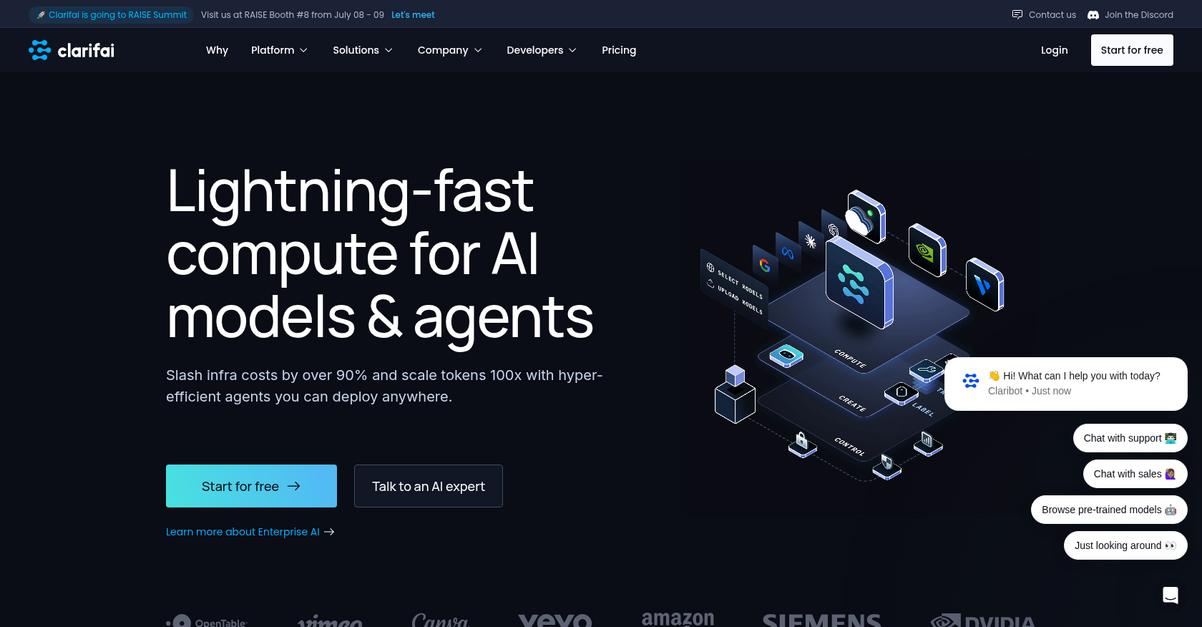
Struggling to scale your image recognition projects efficiently?
Clarifai offers a unified AI platform with compute orchestration and Edge AI, allowing you to streamline complex AI tasks. This means you can focus on building your solution, not managing infrastructure.
If you’re replacing outdated tools or wrestling with information overload, Clarifai provides solutions for real-time processing and integration. This allows you to accelerate development.
Here’s how Clarifai helps you get measurable improvements.
Clarifai’s platform offers lightning-fast inference for custom AI models, deploying in minutes with no infrastructure to manage. You can upload your own models or use pre-deployed trending models, ensuring high efficiency.
Their model-agnostic approach supports custom, open-source, and third-party models, including agentic AI MCP servers. Additionally, automated deployments and seamless auto-scaling ensure your AI projects go live rapidly, saving your team significant development time. The platform dramatically reduces AI latency and provides unrivaled token throughput even under high concurrency, making it ideal for demanding workloads and scaling with your enterprise needs.
The result is optimized performance and controlled costs.
Key features:
- Compute Orchestration: Manage and control your AI workloads across any compute infrastructure, including Edge AI, to optimize performance and reduce operational expenses.
- Automated Deployments: Deploy custom or pre-trained AI models in minutes with push-button functionality and automated scaling, eliminating infrastructure management headaches.
- Flexible Model Support: Host custom, open-source, and third-party models seamlessly, offering comprehensive compatibility and deployment flexibility for diverse AI projects.
Clarifai features, pricing, & alternatives →
Verdict: Clarifai stands out as a top contender for best image recognition software, offering a unified AI platform that significantly reduces infrastructure costs and speeds up development. With features like automated data labeling, model training, and AI workflows, it helps technical product managers and solutions architects overcome evaluation paralysis by providing scalable, cost-efficient, and highly performant solutions for their niche applications.
5. Imagga

Struggling with messy image data and outdated tools?
Imagga offers robust image recognition APIs for automatic tagging, categorization, and visual search. This means you can finally make sense of vast image libraries.
If your current computer vision tools fail on edge cases, Imagga helps organize and understand image content effectively.
Here’s how you unlock true image intelligence.
Imagga solves evaluation paralysis by offering customizable machine learning technology. It’s an all-in-one suite for developers and businesses.
Their tagging, categorization, and cropping APIs automate content organization, empowering product discoverability and digital asset management. You can also train custom models based on your specific needs. This provides immense flexibility and ensures your solution scales as your data grows.
Additionally, Imagga provides advanced features like facial recognition, color extraction, and adult content detection, which are critical for various applications from content moderation to personalized ad targeting. They even offer on-premise deployment for enhanced data privacy.
The result: measurable improvements in operational efficiency.
Before diving deeper, you might find my analysis of best CFD software helpful for complex engineering simulations.
Key features:
- Automated Image Tagging: Automatically assigns relevant tags to your images, making large datasets searchable and improving content organization for various applications.
- Customizable AI Training: Allows you to train your own custom models based on Imagga’s robust image recognition technology, perfect for niche applications and specific business needs.
- Content Moderation Suite: Provides automated adult content detection and a content moderation platform, essential for maintaining brand safety and compliance across platforms.
Imagga features, pricing, & alternatives →
Verdict: Imagga stands out as a leading contender for the Best Image Recognition Software, offering a comprehensive suite of tools. Their advanced APIs for tagging, visual search, and custom training, trusted by over 200 business customers globally, enable scalable solutions for diverse use cases like product discovery and content moderation.
6. IBM
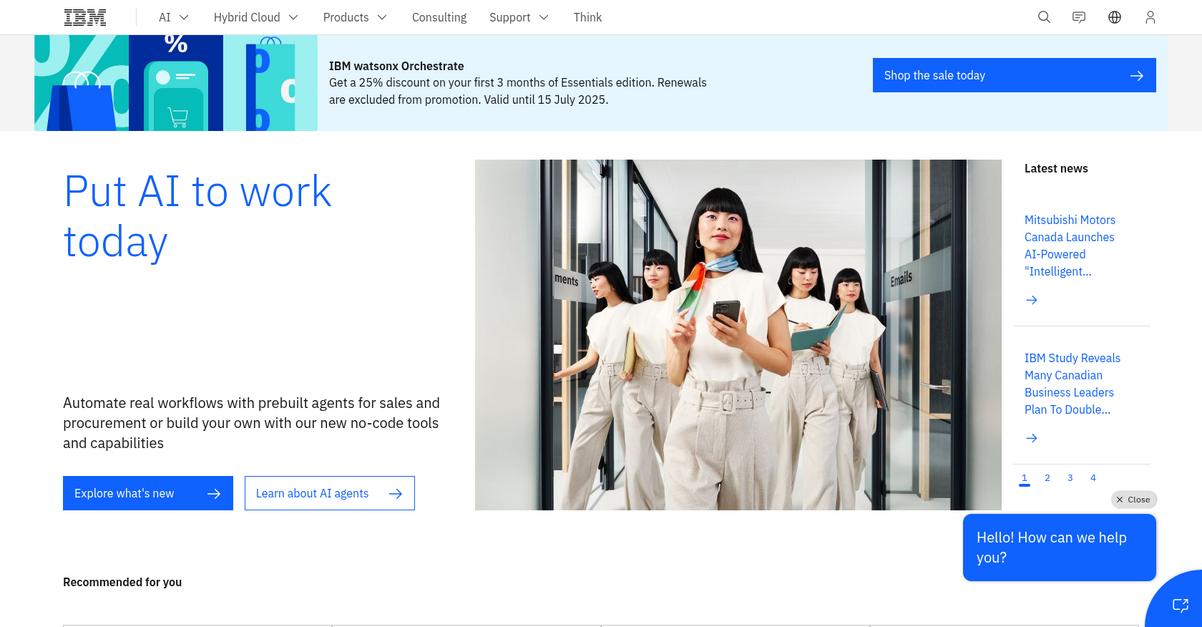
Struggling with complex image recognition challenges?
IBM offers robust AI agents and no-code tools, allowing you to automate real workflows or build custom solutions.
This means you can overcome the struggle of outdated tools that fail to handle edge cases or scale with expanding data volumes.
You’ll find solutions designed to elevate your projects.
IBM helps you move beyond evaluation paralysis by providing AI technologies built for business, capable of supporting data-driven decisions.
This offers scalable solutions that effortlessly integrate into your existing business operations and custom workflows, making implementation smoother.
Additionally, with offerings like Granite Vision topping SLM charts in document understanding and the ability to monitor agentic AI performance with watsonx.governance, you get transparent, reliable performance in uncontrolled environments, crucial for areas like inventory tracking or defect detection.
You’re set for measurable operational improvements.
Speaking of improving operations and cutting costs, my article on best utility billing software can help you achieve perfect accuracy in your billing.
Key features:
- Automated AI agents: Automate real workflows or build your own with no-code tools, reducing complexity and increasing efficiency for critical tasks.
- Scalable AI models: Get cost-efficient AI models, tailored for business and optimized for scale, ensuring your solutions grow with your expanding data volumes.
- AI governance and security: Unify agentic governance and security with industry-first software, providing robust control and reliability for your AI projects.
IBM features, pricing, & alternatives →
Verdict: IBM positions itself as a strong contender for the best image recognition software, offering powerful AI agents and scalable models to tackle complex challenges. Its focus on unifying governance and security, alongside no-code development tools, directly addresses concerns about implementation complexity and data privacy, ensuring reliable performance for your unique projects.
7. The Hive
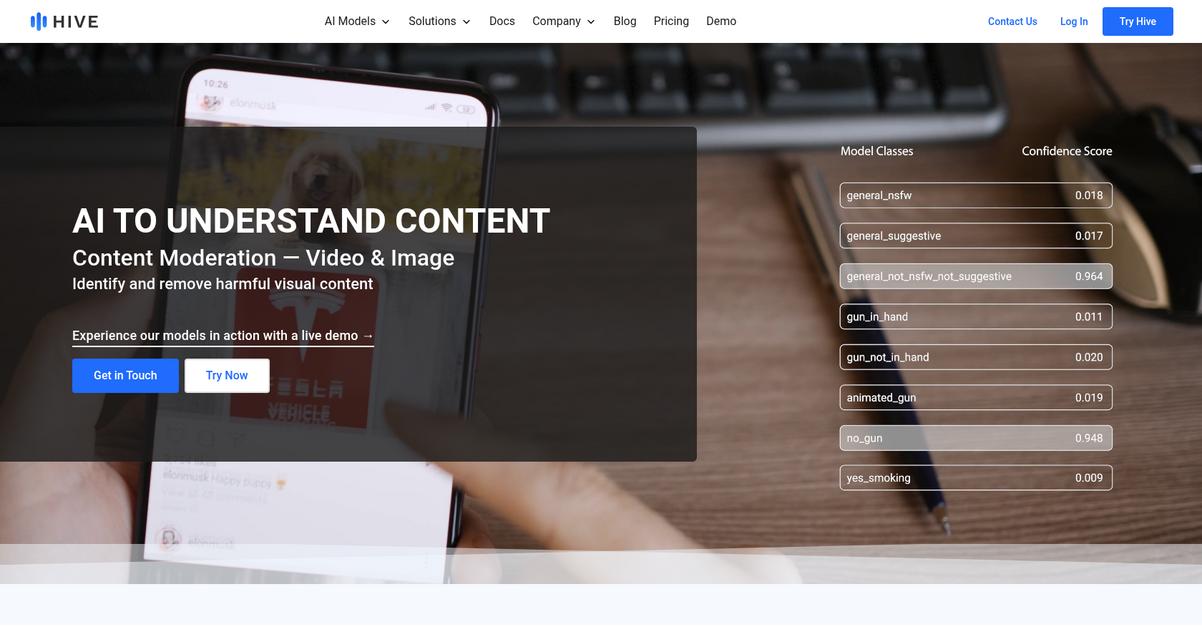
Tired of evaluation paralysis when selecting image recognition software?
The Hive offers industry-leading AI models for visual content understanding, search, and generation. This means you can handle complex image-related tasks efficiently.
Its advanced solutions address core problems like accurately identifying harmful content, protecting brand intellectual property, and detecting fraud with precision. You get human-level accuracy with machine-level efficiency.
Here’s how The Hive delivers solutions.
The Hive empowers businesses to understand, search, and generate various content types at scale, offering rich classification labels for image and video data. This allows you to gain deep insights into your content.
You can leverage next-generation search capabilities on diverse datasets, including web images and intellectual property, making content discovery effortless. Additionally, it offers proprietary and open-source generative AI models to create high-quality images, videos, and text.
The platform provides solutions for content moderation, brand protection, fraud detection, and compliance, enabling you to detect policy violations and implement age verification. This ensures your operations remain secure and compliant across all use cases.
The result is scalable, integrated solutions.
While understanding content insights is crucial, you might also find my guide on best marketing analytics tools helpful for measuring overall business performance.
Key features:
- Content Moderation: Detects and removes harmful visual content like NSFW, hate speech, and CSAM with advanced precision to protect your platform.
- Brand Protection: Monitors intellectual property by tracking logos, celebrity appearances, and detecting unauthorized copies and misuse across various media.
- Fraud Detection: Identifies AI-generated content and identities, detects phishing attempts, and uncovers counterfeits to prevent deceptive media at scale.
The Hive features, pricing, & alternatives →
Verdict: The Hive stands out as a strong contender for best image recognition software, offering AI models with human-level accuracy and machine-level efficiency. Its robust APIs facilitate easy integration, and its proven capabilities in content moderation, brand protection, and fraud detection make it ideal for technical product managers and solutions architects seeking scalable, reliable performance.
8. nyris
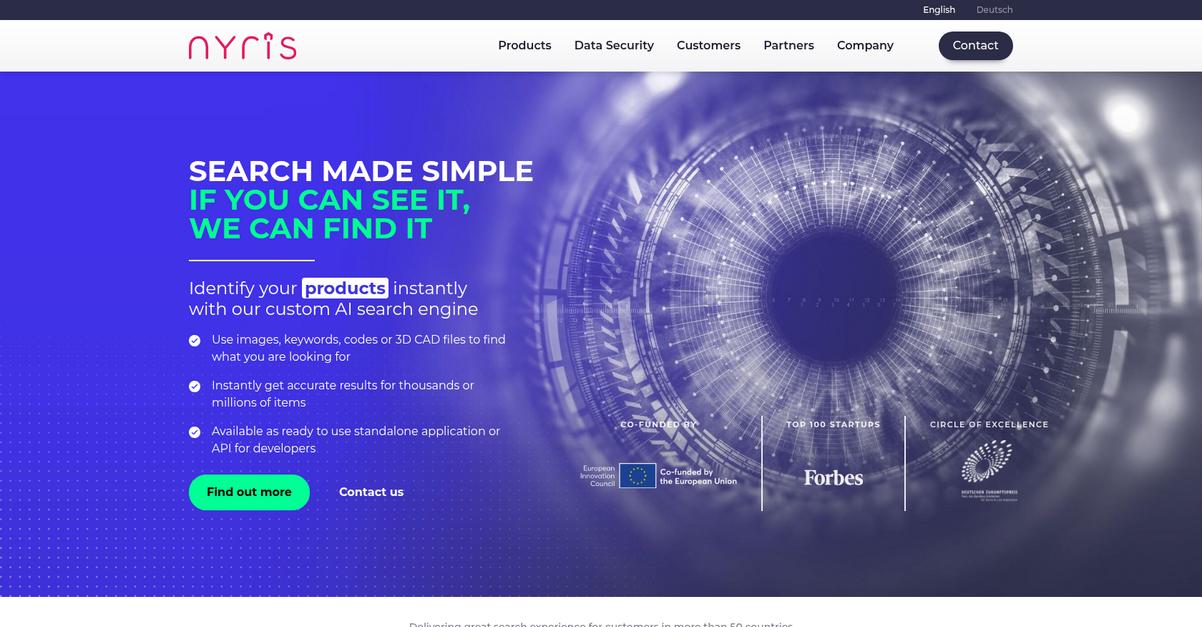
Struggling to identify parts and products instantly?
nyris offers specialized visual search APIs and a No-Code Search Suite to solve complex product identification challenges. This means you can easily find items using images, keywords, codes, or even 3D CAD files.
You can get accurate results for thousands or millions of items, transforming your search capabilities. Plus, it helps avoid frustrated customers and disengaged employees caused by poor search experiences.
Here’s how nyris simplifies identifying what you’re looking for.
Their Visual Search APIs allow developers to build a custom search engine in minutes, enhancing your digital products. You can boost visual search capabilities and accuracy using their versatile APIs. Additionally, nyris offers a Spare Parts Search Suite requiring no technical knowledge, which lets your workforce and customers effortlessly find components. You can use images, keywords, codes, or 3D CAD files to find spare parts. You also get the nyris Portal to manage, monitor, and optimize your visual search solutions, giving you dynamic dashboards to gain a complete overview of search activity and product indexes.
This empowers anyone in your company to become an instant spare part expert.
Before diving deeper, you might find my analysis of best Autodesk partner helpful, especially if you work with design and engineering files.
Key features:
- Visual Search APIs: Build and integrate a custom visual search engine into your website, app, or any application using developer-friendly APIs, including Android, iOS, and JavaScript SDKs.
- Spare Parts Search Suite: Provides a no-code solution for effortless spare parts identification using images, keywords, codes, or 3D CAD files, boosting efficiency for your workforce and customers.
- Synthetic Data Pipeline: Leverage your CAD data to create a custom, fast, and accurate visual search engine 99% faster and 90% cheaper than traditional photography, ideal for large-scale projects.
nyris features, pricing, & alternatives →
Verdict: nyris is an excellent choice for Technical Product Managers and Solutions Architects seeking the best image recognition software, offering high accuracy for spare parts identification and visual search. Its ease of integration and ability to process vast amounts of 3D data efficiently can significantly improve operational efficiency and customer engagement.
Conclusion
Choosing the right tool is critical.
The market is filled with conflicting claims from vendors. This information overload makes selecting the right software for your startup a major challenge.
Advanced systems can achieve 89% accuracy improvements in unstructured data processing. This dramatically reduces manual intervention time by 40%, completely transforming your entire operational workflow and boosting ROI.
Here’s what I recommend for you.
From my research, Google Cloud stands out as the top choice. It directly solves the challenge of scaling with its powerful and unified Vertex AI platform.
The Home Depot uses it for inventory management, proving its real-world power and effectiveness. I believe it’s the best image recognition software for its proven combination of scalability and security.
For additional insights into streamlining your customer interactions, my analysis of best conversational support software provides valuable perspectives.
I highly suggest you start a free trial of Google Cloud. You can see for yourself how its capabilities will accelerate your projects.
You’ll gain a major competitive edge.






